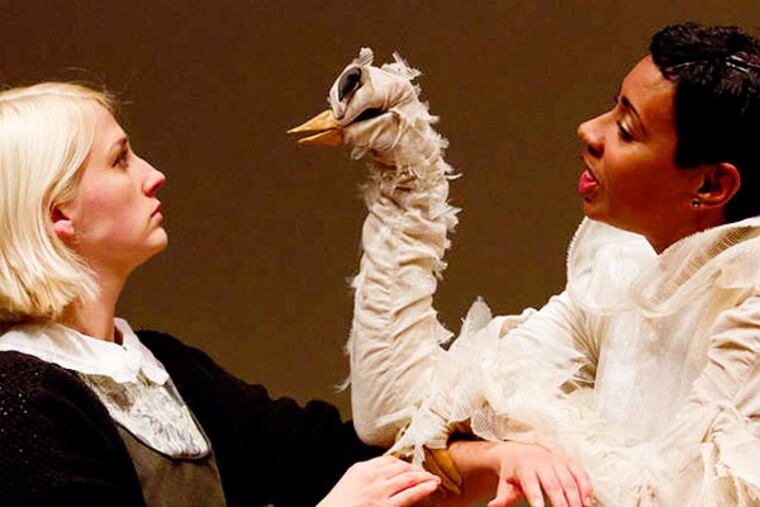Arden presents 'Cinderella' with a touch of Mozart
Generally antic and prone to bellowing, Arden Theatre Company's new Cinderella nonetheless conveys some admirable subtleties about the things people do to each other and why.

Generally antic and prone to bellowing, Arden Theatre Company's new Cinderella nonetheless conveys some admirable subtleties about the things people do to each other and why.
Fairy tales traffic in the black and white. And this production complies, cast in spare colors and a chic aesthetic that shares something with the Anthropologie catalog (costumes by Rosemarie E. McKelvey). Fairy Godmother is swathed in gauzy white, and the ball gown she conjures up for Cinderella is jet black.
But clothes, like people, tend to come in more complex shades of gray, an idea this adaptation by Charles Way, as directed by Whit MacLaughlin, dares to add in tender layers. Much of the movement is in elegant shadows thrown from behind six tall white scrims on which birds flutter and the glass slipper in question spins. (Scenic designer David P. Gordon lent a marvelous handmade quality to visuals.) The wicked stepsisters aren't inherently wicked, they are lashing out because they miss their dead father - a gray area that plays with our sympathies.
Way's script, first produced more than a decade ago on U.K. stages like London's Polka Theatre, introduces an unexpected element: Mozart. The show doesn't have the strong writing - a pleasure never lost on a child's ear - that other Arden children's shows have had (Charlotte's Web). But woven throughout the production, we hear Eine Kleine Nachtmusik, Mozart piano concertos, one of the particularly poignant piano fantasies (No. 3), and other works. The music, curated by sound designer Jorge Cousineau, works best in recordings of actual acoustic instruments rather than when rendered electronically.
Mozart spills over into the characterizations. Fairy Godmother (nobly drawn by Kala Moses Baxter) enters as an avatar, a bird operated as a hand puppet, but even in human form she takes on the jerky bird movements of Mozart's Papagena. Way added Wolfgang (played with puppy-dog energy by Matteo Scammell), a court composer in punk rock hair and black nail polish whose music has something to do with how Cinderella and the Prince (the lithe and appealing Peterson Townsend) end up together.
Whether Wolfie is snared by one of the stepsisters (Alex Keiper and Miriam White, both deliciously dopey) isn't something we get to see, but we can guess. One is named Constanze, Mozart's real-life wife. If blandness was the target for Joe Guzmán's Sigmund, Cinderella's father, he more or less got there. His new wife, Maria (Susan Riley Stevens), achieved pitch-perfect haughtiness.
The appearance of the Overture to "The Marriage of Figaro" is a nice reference to coming nuptials, sounding its fevered eighth notes at the same moment Fairy Godmother was turning pumpkin and rat into coach and coachman for Cinderella (portrayed by Mary Tuomanen with freshly contemporary vocal inflections).
The aforementioned bellowing mostly issued from Benjamin Lloyd in a Dom DeLuisian portrayal of the bedridden king. Adults may find it grating - and cringe at his use of the phrase "shut up" - but children Saturday night audibly delighted in all the whining and ordering about at the top of his lungs before regaining happiness and mobility. God may have saved the king. But with two months of performances ahead of him, you wonder who will save his voice.